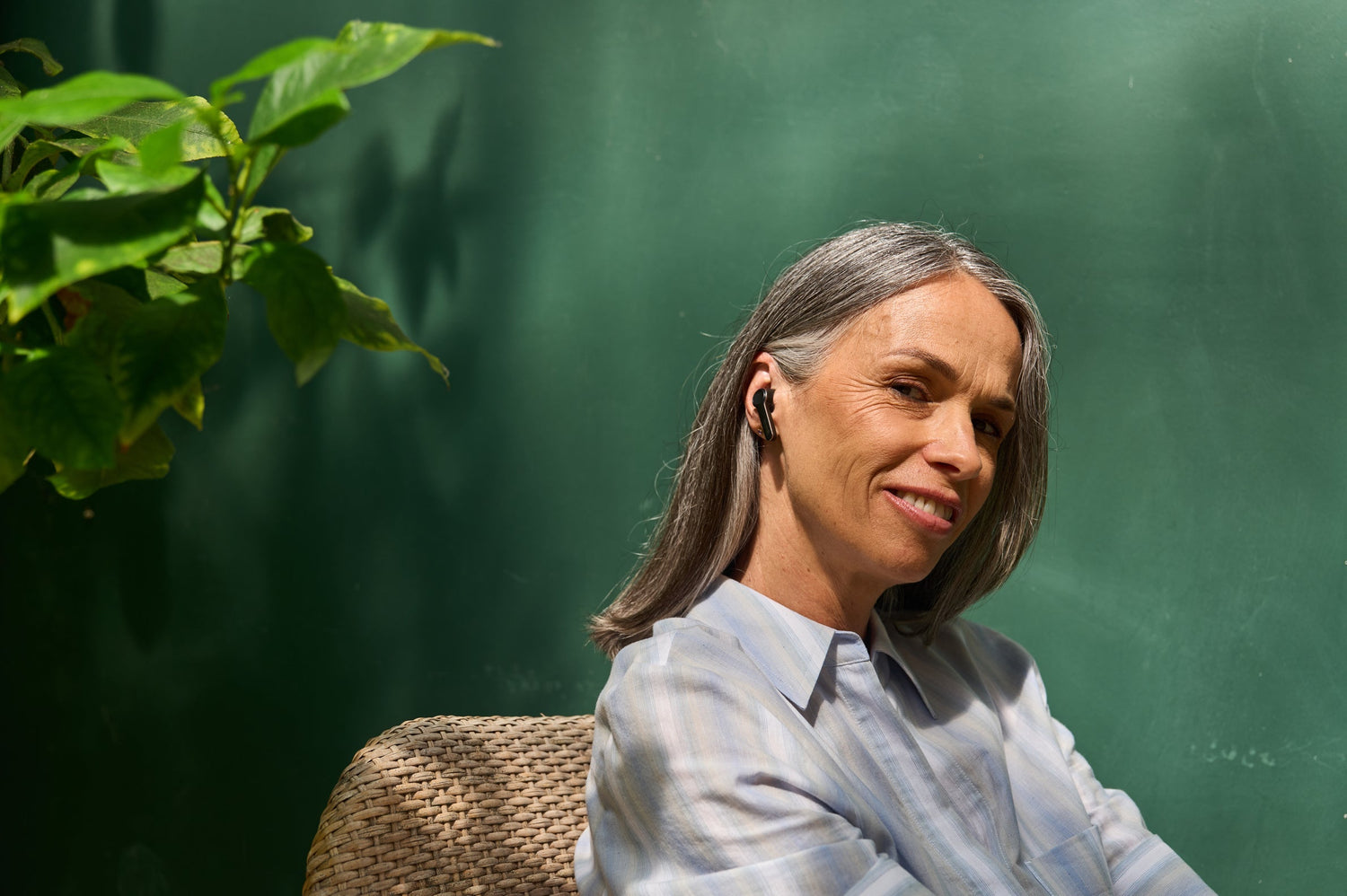Wondering if ITE hearing aids are the right fit for you? As one of the most popular types of in-ear devices, ITEs offer both discretion and advanced hearing capabilities. With features such as Bluetooth compatibility, rechargeable batteries, and custom molding, ITE hearing aids are where many people begin their hearing aid journey. If you want to learn more about ITE hearing aids, this blog is the ultimate guide for beginners, covering everything you need to know. Just read on to find what ITE means, pricing, how they compare to ITC and BTE models, who they’re best for, and even how to care for them.
🚀 Navigate This Post
- ➤ Part 1: What Does ITE Mean in Hearing Aids?
- ➤ Part 2: ITE Hearing Aids Price
- ➤ Part 3: Why Wear ITE Hearing Aids? — Pros & Ideal Users
- ➤ Part 4: ITE vs ITC: Which One Is Right for You?
- ➤ Part 5: Best ITE Hearing Aids — How to Choose the Right One?
- ➤ Part 6: How to Maintain the ITE Hearing Aids?
- ➤ Frenquently Asked Questions
You may also be interested in:
- Comprehensive Guide: Everything You Need to Know about Hearing Aids
- Best Hearing Aids to Reduce Background Noise for Seniors
- Best Rechargeable Bluetooth Hearing Aids: Worth It vs. Traditional?
Part 1: What Does ITE Mean in Hearing Aids?
What is ITE hearing aids? ITE stands for In-The-Ear. It’s a hearing aid style where all components like the microphone, receiver, amplifier, and battery are packed into a custom-molded shell. Unlike BTE (Behind-The-Ear) models, which rest behind the ear and connect via tubing, ITE hearing aids sit entirely within the outer ear.

ITE hearing aids have a more discreet solution, suitable for users with mild to severe hearing loss. They are available in both full-shell and half-shell versions to accommodate different ear sizes and hearing needs. Compared to other models, ITE aids are equipped with easier controls and larger batteries.
If you are new to hearing aid options, you can learn more about the types, features, and pros and cons in this guide to everything about hearing aids.
Part 2: ITE Hearing Aids Price
According to Audiologists.org, the typical ITE hearing aids price range is $1,000 to $6,000 per pair. On average, a single device costs between $1,000 and $3,500, depending on the model and service package.
Pricing is primarily influenced by the features offered. While premium versions may include Bluetooth streaming, rechargeability, or AI noise reduction, basic models offer essential amplification.

Brand reputation, level of customization, and inclusion of services like hearing tests, fitting, and warranty can significantly impact the cost.
Compared to prescription models, OTC (over-the-counter) ITE hearing aids are much cheaper, often priced between $300 and $1,500 per pair.
Part 3: Why Wear ITE Hearing Aids? — Pros & Ideal Users
ITE hearing aids are popular for individuals who value a blend of functionality and comfort. Fitting completely within the outer ear, they offer several advantages over other styles. Many of today’s best OTC hearing aids now come in ITE styles.
Custom fit to your ear: ITE devices are molded to your ear shape, ensuring comfort and better sound delivery.
Larger size with more features: The larger shell supports manual volume control and memory settings, unlike smaller models.
Larger battery capacity: ITE hearing aids often use bigger batteries or offer rechargeable models for longer use.
Easier to insert and handle: Ideal for users with dexterity issues.

ITE hearing aids are suitable for:
Individuals with mild to moderate hearing loss: With strong amplification and noise reduction.
Individuals who value discretion: Their position inside the ear makes them less visible.
Active individuals: Custom fit ensures they stay in place during activity.
Glasses or oxygen tube wearers: Since they don’t sit behind the ear, they’re more comfortable.
Part 4: ITE vs ITC: Which One Is Right for You?
What is the difference between ITE and ITC hearing aids? Both are custom-molded and fit inside the ear, but differ in size, visibility, and features.

ITE: Larger, fills more of the outer ear, allows for bigger batteries, easier handling, and more features.
ITC: Smaller, sits partly in the canal, more discreet, but limited in battery life and manual control.
Here’s a quick comparison:
| Feature | ITE Hearing Aids | ITC Hearing Aids |
|---|---|---|
| Size | Larger | Smaller |
| Visibility | Slightly visible | More discreet |
| Features | More built-in options | Fewer due to space limits |
| Handling | Easier | It may be tricky for some |
| Hearing Loss Range | Mild to severe | Mild to moderate |
Part 5: Best ITE Hearing Aids — How to Choose the Right One?
Now you should know everything about ITE hearing aids. So, how to choose the right one? Just follow these steps.
Step 1. Get a hearing checkup
Visit your doctor to rule out treatable causes of hearing loss, like earwax buildup or infection.
Step 2. See an audiologist
Assess your hearing. Severe or profound loss usually requires prescription devices.
Step 3. Know which features matter
When comparing ITE options, consider important features such as:
- ITE hearing aids with Bluetooth are great for direct phone and audio connectivity.
- Noise reduction technology for clearer sound; rechargeable with fast-charging options for easy daily use.
- Choose additional desired features such as app controls, scene modes, noise filtering, and memory settings based on your lifestyle.

Step 4. Ask about a trial period
Make sure you get details in writing about the length of the trial, associated costs, and refund policy if the hearing aid doesn’t suit you.
Step 5. Review the warranty
Make sure the device comes with a warranty that covers parts, labor, and ideally, follow-up visits. Ask if you can extend the coverage.
Step 6. Consider your budget
Generally, Medicare doesn’t cover hearing aids for adults. But some private insurances, veteran programs, or nonprofit organizations may help cover the cost.
If you have mild to moderate hearing loss and are looking for a blend of advanced features, value, and ease of use, the Cearvol Diamond X1 is a top recommendation you can consider.

Diamond X1 - Best Hearing Aids with Bluetooth
Newcomer Price
$249.99 $309.99
- ✔ Adaptive sound modes for clear hearing.
- ✔ Bluetooth for calls & streaming.
- ✔ App-controlled, customizable adjustments.
- ✔ Rechargeable & fast charging.
- ✔ Ideal for mild to moderate hearing loss.
Here’s why it stands out as the best ITE hearing aid:
- Innovative 16‑channel WDRC (Wide Dynamic Range Compression) with AI noise reduction to deliver sharper sound in different environments.
- Bluetooth 5.3 connectivity to ensure low-latency audio streaming, which is best for phone calls and media across iOS and Android devices.
- Switch between Indoor, Conversation, Restaurant, and Traffic scenes with voice prompts.
- Long-lasting rechargeable battery: up to 12 hours per charge plus 24 hours in the charging case; a quick 10-minute charge can deliver up to 3 hours of use.
- Discreet earbud-style design, lightweight with comfortable ear tips; IPX5 water/dust resistance for active users.
Part 6: How to Maintain the ITE Hearing Aids?
Like other delicate devices, ITE hearing aids require proper maintenance for optimal condition. Here are simple steps to follow:
- Clean daily: Gently wipe the device with a dry cloth and use cleaning tools to remove earwax from openings.
- Store safely: Keep your ITE hearing aids in a dry storage case when not in use.
- Avoid moisture: Never expose them to water, steam, or high humidity.
- Protect from products: Keep them away from hairspray, makeup, or lotion.
- Schedule maintenance: Visit your audiologist regularly for deep cleaning and checkups.
You can also learn more about the maintenance from the full guide here: How to clean hearing aids.
Frequently Asked Questions




コメントを書く
全てのコメントは、掲載前にモデレートされます
このサイトはhCaptchaによって保護されており、hCaptchaプライバシーポリシーおよび利用規約が適用されます。